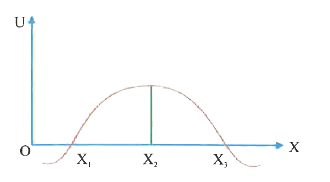A particle oscillates about the stable equilibrium position x0 with a small amplitude subjected to a force that has an associated potential energy u(x). Which of the following about u(x) is true (no implsive force)
u(x) must be symmetric about x0
u(x) must have a minima at x0
u(x) may have maxima at x0
u(x) may be position in the vicinity of x0
The correct Answer is:B, D
The only need for oscillation is potential energy should have a minima and for the amplitude given it should not cross the valley.
Topper's Solved these Questions
- BOOK - NARAYNACHAPTER - OSCILLATIONSEXERCISE - ASSERTION & REASON QUESTIONS13videos
OSCILLATIONS
- BOOK - NARAYNACHAPTER - OSCILLATIONSEXERCISE - LEVEL-V1videos
OSCILLATIONS
- BOOK - NARAYNACHAPTER - OSCILLATIONSEXERCISE - NCERT BASED QUESTIONS1videos
OSCILLATIONS
- BOOK - NARAYNACHAPTER - NEWTONS LAWS OF MOTIONEXERCISE - PASSAGE TYPE QUESTION6videos
NEWTONS LAWS OF MOTION
- BOOK - NARAYNACHAPTER - PHYSICAL WORLDEXERCISE - C.U.Q10videos
PHYSICAL WORLD
Similar Questions
A 2.00 kg particle moves along an x axis in onedimensional motion while a conservative force along that axis acts on it. The potential energy U(x) associated with the force is plotted in Fig. 8-36a. That is, if the particle were placed at any position between x=0 and x=7.00m, it would have the plotted value of U. At x=6.5m, the particle has velocity →v0=(−4.00m/s)ˆi.
(c) Evaluate the force acting on the particle when it is in the region 1.9 m<x<4.0 m.View SolutionIf x,F and U denote the dispalcement, force acting on and potential energy of a particle then
View Solution
Knowledge Check
- Question 1 - Select One
U is the PE of an oscillating particle and F is the force acting on it at a given instant . Which of the following is true ?
AUF+x=0B2UF+x=0CFU+x=0DF2U+x=0 - Question 2 - Select One
U is the PE of an oscillating particle and F is the force. if acting on it at a given instant. Which of the following true?
AUF+x=0B2UF+x=0CFU+x=0DF2U+x=0 - Question 3 - Select One
If x,F and U denote the dispalcement, force acting on and potential energy of a particle then
AU=FBF=+dUdxCF=−dUdxDF=1x(dUdx)
In the fig. The potential energy U of a particle plotted against its position x from origin. Which of the following statement is correct
 View Solution
View SolutionPotential energy of a particle at position x is given by U=x2−5x. Which of the following is equilibrium position of the particle?
View SolutionPotential energy of a particle at position x is given by U=(x2−4x)J. Which of the following is equilibrium position of the particle?
View SolutionA particle undergoing forced oscillations has maximum amplitude for frequency V1 of the force . Then Which of the following statement is true ?
View SolutionA particle which is constant to move along the x−aξs , is subjected to a force in the same direction which varies with the distance x of the particle from the origin as F(x)=−Kx+ax3 . Hero K and a are positive constant . For x≥0, the fanctional from of the patential every U(x) of the particle is
View Solution

